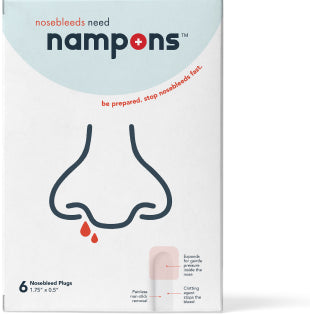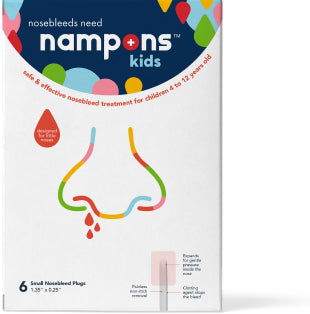This article was written by Dr. Baran Erdik is an M.D. with further specialization in Internal Medicine/Cardiology. He traveled the world, working as a physician in New Zealand, Germany and Washington State.
Epistaxis, or nosebleed, is a common occurrence, affecting more than 60% of people at some point in their lives. Interestingly, the occurrence of nosebleeds follows a bimodal pattern, meaning it is even more frequent among the young and the elderly. Little's area, a region in the septum that divides the nose, is responsible for over 90% of nosebleeds. This area contains a network of interconnected blood vessels known as anastomoses. Any damage to the lining of these vessels can lead to bleeding, which is ultimately stopped by the body's clotting mechanisms.
Blood thinners, also known as anticoagulants, are medications that inhibit the blood clotting cascade at different stages. The clotting process involves two separate but interconnected pathways: the intrinsic and extrinsic pathways. The intrinsic pathway responds to internal damage in the blood vessel linings, preventing bleeding from occurring in the first place. On the other hand, the extrinsic pathway is activated after a blood vessel is damaged, initiating the clotting process. While the initial steps of these pathways are distinct, they converge at the common end stages before clot formation, which is the point where most blood thinners exert their effects. Therefore, the term "blood thinner" can be misleading, as these medications actually prevent clots from forming rather than thinning the blood.
The use of blood thinners is widespread, as they are commonly prescribed for various ailments such as atrial fibrillation or other heart arrhythmias, as well as valve issues that affect almost 15% of 80-year-olds. In the same context, several studies have demonstrated that more than 1 in 8 seniors are on anticoagulants.
The effect of blood thinners on epistaxis can be twofold. On one hand, anticoagulants can increase the prevalence of nosebleeds due to their interference with the normal clotting process. Furthermore, blood thinners can prolong the time it takes for the blood to clot, making it more challenging for the body to stop bleeding from damaged blood vessels, potentially leading to more severe bleeding from nosebleeds. In this context, studies have demonstrated that almost 25% of individuals on anticoagulants experience nosebleeds annually.
Aspirin, a nonsteroidal anti-inflammatory drug (NSAID), is commonly known as a blood thinner. Although aspirin is not an anticoagulant in the strict sense, it functions as an antiplatelet agent, preventing platelets (the cells that clump together to form a blood clot) from sticking together. While the antiplatelet effect of aspirin is generally not potent enough for active treatment of most diseases, it is frequently used for secondary prevention of many cardiovascular conditions, including strokes or heart attacks. When it comes to its effect on epistaxis, the data is less well-defined. Some studies have shown that daily aspirin users have more than double the risk of nosebleeds compared to non-users, while other studies have failed to demonstrate an increased risk. Similarly, no studies have indicated an increased risk of epistaxis with other NSAIDs, such as ibuprofen. However, interestingly, studies have shown that patients taking aspirin may require more frequent surgical intervention to stop bleeding. This can be partly explained by the fact that aspirin does not prevent the intrinsic pathway but primarily targets the final step of clot formation.
Fortunately, most nosebleeds are not severe and do not require medical intervention, with only 10% of individuals with epistaxis seeking medical services. However, if you are on blood thinners and experience a nosebleed, it may be necessary to seek medical attention as you are at a higher risk for severe bleeding. After a thorough evaluation, your physician may decide to administer medications to counteract the blood thinners in your system, refer you to surgery to stop the bleeding, or carefully monitor your progress. In the event of a nosebleed, it is important to stay calm, sit up straight, lean forward slightly, and pinch your nostrils together. The use of a nasal tampon or nasal plug is also recommended. to control the bleeding. These measures help control the bleeding and prevent blood from flowing down the throat.
In addition to the preventive measures and management strategies mentioned earlier, there are further considerations and precautions individuals on blood thinners can take to minimize the risk and impact of nosebleeds.
Regular follow-ups with healthcare professionals are crucial for individuals on blood thinners. These check-ups allow for the monitoring of the medication's effectiveness and any potential side effects, including an increased propensity for nosebleeds. Healthcare providers may adjust the dosage or switch to alternative anticoagulant medications if necessary. It is worth noting that any changes in medication or management strategies should be discussed and approved by a healthcare professional. Abruptly stopping or altering the dosage of blood thinners without medical guidance can have serious implications for individuals with underlying cardiovascular conditions.
Moreover, maintaining good nasal hygiene is essential for individuals on blood thinners. This includes gently cleaning the inside of the nose with a saline solution or using a nasal rinse to keep the nasal passages moist and reduce the risk of irritation. It is important to follow the proper technique recommended by healthcare professionals when performing nasal hygiene to avoid any accidental injury to the delicate nasal tissues.
When it comes to lifestyle choices, certain habits can help minimize the risk of nosebleeds. Avoiding activities that may irritate the nasal passages, such as vigorous nose picking or forceful blowing of the nose, is crucial. It is advisable to use a soft tissue or a clean cloth when gently blowing the nose. Engaging in activities that promote overall nasal health, such as humidifying the air in dry environments and staying well-hydrated by drinking plenty of fluids, can also be beneficial.
While nosebleeds can be a nuisance, it is essential to maintain perspective and understand that they are often manageable and rarely indicate a life-threatening situation. By staying informed, taking preventive measures, and working closely with healthcare professionals, individuals on blood thinners can minimize the impact of nosebleeds on their daily lives.
Lastly, it is crucial to remember that the information provided in this article is for informational purposes only and should not replace professional medical advice. If you have concerns or questions about nosebleeds or the effects of blood thinners, it is always best to consult with a qualified healthcare professional who can provide personalized guidance based on your specific situation.
Reference:
- Prevalence of Aspirin Use for Primary Prevention of Cardiovascular Disease in the United States: Results From the 2017 National Health Interview Survey. O'Brien CW, Juraschek SP, Wee CC. Ann Intern Med. 2019 Jul 23. doi: 10.7326/M19-0953. [Epub ahead of print]
- Soyka MB, Rufibach K, Huber A, et al. Is severe epistaxis associated with acetylsalicylic acid intake? Laryngoscope. 2010 Jan;120(1):200-7.
- Yau S. An update on epistaxis. Aust Fam Physician. 2015 Sep;44(9):653-6.
- Chen Q, Lapane K, Nunes AP, Tjia J, Hugunin J, Alcusky M. Prevalence and the factors associated with oral anticoagulant use among nursing home residents. J Clin Pharm Ther. 2021;46(6):1714-1728.
- Beran M, Petruson B. Occurrence of epistaxis in habitual nose-bleeders and analysis of some etiological factors. ORL J Otorhinolaryngol Relat Spec. 1986;48(5):297-303.
- Lavy J. Epistaxis in anticoagulated patients: educating an at-risk population. Br J Haematol. 1996;95(1):195-197.
About Dr. Baran Erdik
Dr. Baran Erdik is an M.D. with further specialization in Internal Medicine/Cardiology. He traveled the world, working as a physician in New Zealand, Germany and Washington State.
After earning his Master’s in Healthcare Administration and Policy from Washington State University, graduating summa cum laude, he decided to make a turn in his career. His master’s degree opened the door for him to a different aspect of the healthcare industry which highly piqued his interest. He found his new passion in consulting for hospitals and medical practices, where he could leverage his physician experience – understanding the needs of the clinicians – as well as his studies in healthcare administration.
He has now settled down in Atlanta, consulting for healthcare facilities, and helps CSR on a wide range of issues: mergers and acquisitions, policy compliance, and savings and efficiency, among others. What he enjoys most in his work is the need to constantly adapt to challenges and changes. It makes every day different and worth going to work for.
He has also done research on evidence-based medicine, focused on how big data can be used in medicine and consulting.



